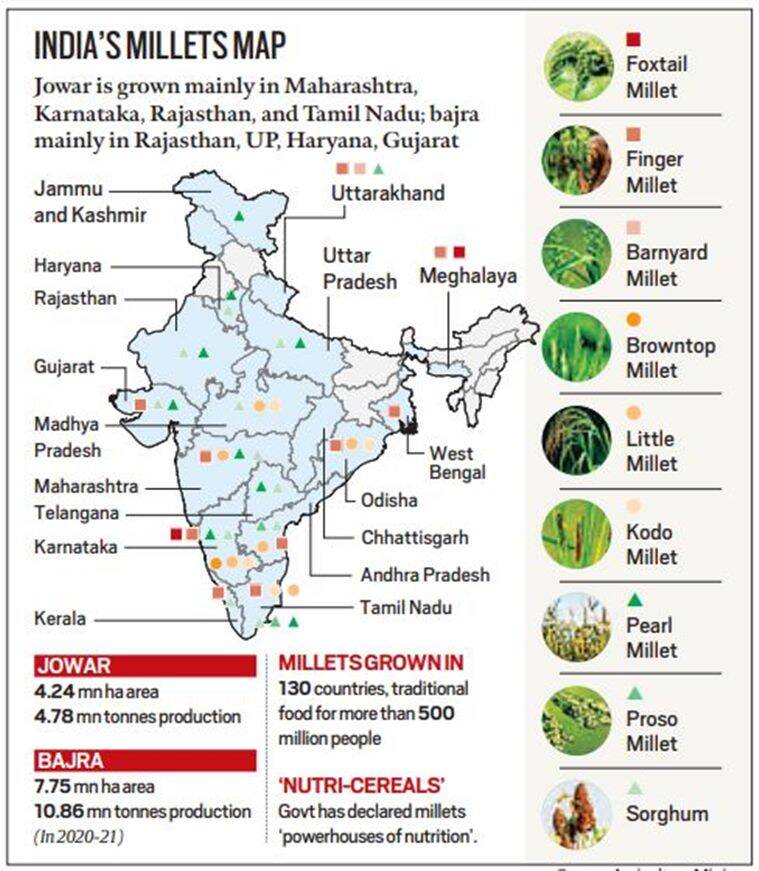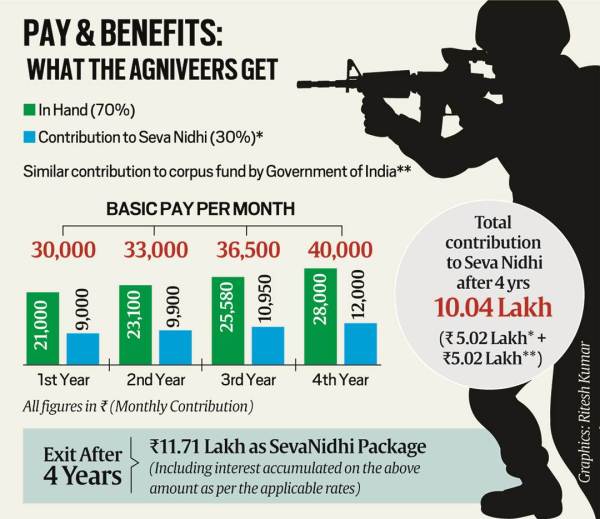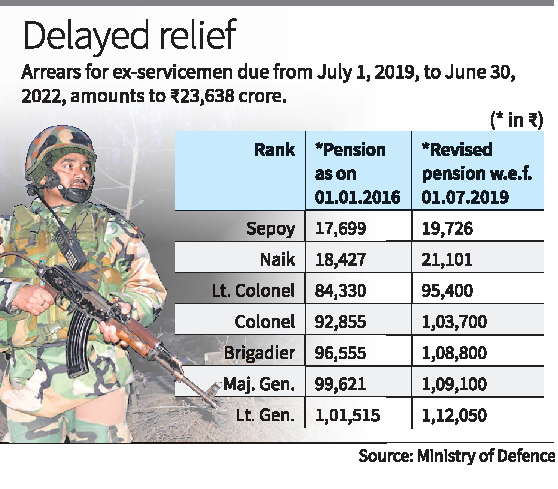CONTENTS
- MIIRA initiative
- Agnipath Scheme
- One rank, One pension
- National Data and Analytics Platform
- Bisphenol A
- Banjara Community
MIIRA Initiative
Context:
India has introduced a draft to launch a global initiative to encourage the consumption and production of millet. The draft of the proposed initiative — MIIRA — was placed during the first Agriculture Deputies Meeting under the Agriculture Working Group (AWG), G20 at Indore, Madhya Pradesh.
Relevance:
GS II: Government policies and Interventions
Dimensions of the Article:
- What is MIIRA?
- About Millets crop
- About International Year of Millets
What is MIIRA?
- The acronym MIIRA stands for ‘Millet International Initiative for Research and Awareness’.
- The MIIRA will be aimed at coordinating millet research programmes at the international level.
- It is in line with the UN declaring 2023 as the International Year of Millets, the proposal for which was moved by India and supported by 72 countries.
- The International Year will see several events and activities such as conferences, issuing of stamps and coins etc. to raise awareness about millets, improve their production and quality, and attract investments.
- The Centre also plans to make India a global hub for millets.
What is the aim of MIIRA?
- MIIRA will aim to connect millet research organisations across the world while also supporting research on these crops.
- This is significant as issues like food security and nutrition are among the key priority areas in the agriculture sector during India’s G20 Presidency. India assumed the G20 Presidency on December 1, 2022.
- Besides setting up a web platform to connect researchers and holding international research conferences, the plan is also to raise awareness for promoting the consumption of millet.
Who will fund the MIIRA initiative?
- For MIIRA to take off, India will contribute the “seed money”, while each G20 member will later have to contribute to its budget in the form of a membership fee.
- The MIIRA secretariat will be in Delhi, the sources said, adding that with India being a major producer of millets, this will ensure a flow of investment from the country’s industry and research bodies.
About Millets crop:

- The word millets is used to describe small-grained cereals like sorghum (jowar), pearl millet (bajra), foxtail millet (kangni/ Italian millet), little millet (kutki), kodo millet, finger millet (ragi/ mandua), proso millet (cheena/ common millet), barnyard millet (sawa/ sanwa/ jhangora), and brown top millet (korale).
- Millets were among the first crops to be domesticated.
- There is evidence for consumption of millets by the Indus valley people (3,000 BC), and several varieties that are now grown around the world were first cultivated in India.
- West Africa, China, and Japan are home to indigenous varieties of the crop.
- They require much less water than rice and wheat, and are mainly grown in rainfed areas.
- Globally, sorghum (jowar) is the biggest millet crop.
- The major producers of jowar are the United States, China, Australia, India, Argentina, Nigeria, and Sudan. Bajra is another major millet crop; India and some African countries are major producers.
- In India, millets are mainly a kharif crop. During 2018-19, three millet crops — bajra (3.67%), jowar (2.13%), and ragi (0.48%) — accounted for about 7 per cent of the gross cropped area in the country, Agriculture Ministry data show.
Advantages of promoting millets
- Millets are considered to be “powerhouses of nutrition”.
- Millets are less expensive and nutritionally superior to wheat & rice owing to their high protein, fibre, vitamins and minerals like iron content.
- Millets are also rich in calcium and magnesium.
- Its high iron content can fight high prevalence of anaemia in Indian women of reproductive age and infants.
- They are also harder and drought-resistant crops, which has to do with their short growing season (70-100 days, as against 120-150 days for paddy/wheat) and lower water requirement (350-500 mm versus 600-1,200 mm).
- As low investment is needed for production of millets, these can prove to be a sustainable income source for farmers.
- Millets can help tackle lifestyle problems and health challenges such as obesity and diabetes as they are gluten-free and have a low glycemic index (a relative ranking of carbohydrates in foods according to how they affect blood glucose levels).
About International Year of Millets:
- India’s proposal to observe an International Year of Millets in 2023 was approved by the Food and Agriculture Organisation (FAO) in 2018 and the United Nations General Assembly has declared the year 2023 as the International Year of Millets.
- This was adopted by a United Nations Resolution for which India took the lead and was supported by over 70 nations.
- Aim is to increase the domestic and global consumption of Millets.
Objectives:
- Awareness of the contribution of millet to Food Security and nutrition.
- Inspire stakeholders to improve sustainable production and quality of millets.
- Focus on enhanced investment in research and development and extension services to achieve the other two aims.
-Source: The Hindu
Agnipath Scheme
Context:
Recently, The Delhi High Court upheld the validity of the Agnipath scheme launched by the Union government for recruitment in the armed forces.
Relevance:
GS II- Government policies and Interventions
Dimensions of the Article:
- What is the Agnipath scheme?
- What is the eligibility criteria?
- What happens after selection?
- When will the recruitment actually begin?
- How will the scheme benefit the armed forces and the recruits?
What is the Agnipath scheme?
- Under the new scheme, around 45,000 to 50,000 soldiers will be recruited annually, and most will leave the service in just four years.
- Of the total annual recruits, only 25 per cent will be allowed to continue for another 15 years under permanent commission.
- The move will make the permanent force levels much leaner for the over 13-lakh strong armed forces in the country.
- This will, in turn, considerably reduce the defence pension bill, which has been a major concern for governments for many years.
What is the eligibility criteria?

- The new system is only for personnel below officer ranks (those who do not join the forces as commissioned officers).
- Under the Agnipath scheme, aspirants between the ages of 17.5 years and 23 years will be eligible to apply.
- The recruitment standards will remain the same, and recruitment will be done twice a year through rallies.
What happens after selection?
- Once selected, the aspirants will go through training for six months and then will be deployed for three and a half years.
- During this period, they will get a starting salary of Rs 30,000, along with additional benefits which will go up to Rs 40,000 by the end of the four-year service.
- Importantly, during this period, 30 per cent of their salary will be set aside under a Seva Nidhi programme, and the government will contribute an equal amount every month, and it will also accrue interest.
- At the end of the four-year period, each soldier will get Rs 11.71 lakh as a lump sum amount, which will be tax-free.
- They will also get a Rs 48 lakh life insurance cover for the four years.
- In case of death, the payout will be over Rs 1 crore, including pay for the unserved tenure.
- However, after four years, only 25 per cent of the batch will be recruited back into their respective services, for a period of 15 years.
- For those who are re-selected, the initial four-year period will not be considered for retirement benefits.
When will the recruitment actually begin?
- Recruitment will begin within 90 days under the scheme which will bring “all India, all class” recruitment to the services.
- This is especially significant for the Army, where the regiment system has region and caste bases, and with time that will be eliminated to allow anybody from any caste, region, class or religious background to become part of existing regiments.
How will the scheme benefit the armed forces and the recruits?
- The average age in the forces is 32 years today, which will go down to 26 in six to seven years, the scheme envisions.
- It will create “future-ready” soldiers.
- A youthful armed forces will allow them to be easily trained for new technologies.
- It will increase employment opportunities and because of the skills and experience acquired during the four-year service such soldiers will get employment in various fields.
- This will also lead to availability of a higher-skilled workforce to the economy which will be helpful in productivity gain and overall GDP growth.
- The government will help rehabilitate soldiers who leave the services after four years. They will be provided with skill certificates and bridge courses. The impetus will be to create entrepreneurs.
-Source: The Hindu
One Rank, One pension
Context:
Recently, The Defence Ministry came under fire from the Supreme Court for tweaking a judicial order to pay the entire arrears under the One Rank One Pension (OROP) scheme by March 15.
Relevance:
GS II- Government policies and Interventions
Dimensions of the Article:
- About One rank, one pension
- Issues with OROP
- What has the SC ruled now?
- Challenge to OROP
About One rank, one pension

- OROP means that any two military personnel retiring at the same rank, with the same years of service, must get an equal pension.
- While this might appear almost obvious, there are several reasons why two military personnel who may have retired at the same rank with the same years of service, may get different pensions.
- Military personnel across the three services fall under two categories,
- the officers
- the other ranks
- The other ranks, which are soldiers, usually retire at age 35.
- Unlike government employees who retire close to 60, soldiers can thus miss out on the benefits from subsequent pay commissions.
- And since pensions are based on the last drawn salary, pensions too are impacted adversely.
- Similarly, the age when officers in the military retire depends upon their ranks.
- Uttar Pradesh and Punjab have the highest number of OROP beneficiaries.
- Armed Forces Personnel who had retired till 30th june 2014 are covered under it.
- The implementation of the scheme was based on recommendation of the Koshiyari committee.
Earlier Pension Mechanism:
- From 1950 to 1973, there was a concept known as the Standard Rate of Pension, which was similar to OROP.
- In 1974, when the 3rd Pay Commission came into force, certain changes were effected in terms of weightage, additional years of notion service, etc., with regard to pensions.
- In 1986, the 4th Pay Commission’s report brought further changes.
- What ultimately happened was that the benefits of the successive pay commissions were not passed to servicemen who had retired earlier.
- Pensions differed for those who had retired at the same rank, with the same years of service, but years apart.
Issues with OROP
- It was constantly asserted during the OROP protests of 2013-15 that meeting the demand would be financially unsustainable.
- The Defence Ministry’s pension budget is quite big, affecting capital expenditure, because soldiers retire early and are entitled for pension for much longer than other employees.
- The total number of defence pensioners is 32.9 lakh, however that number includes 6.14 lakh civilian defence pensioners.
- In the fiscal year 2019-2020, the Defence Ministry spent Rs 1.18 lakh crore on pensions.
- The Defence Ministry has the largest pension-to-budget ratio of any ministry, with pensions accounting for more than one-fifth of the total defence budget.
- When Manohar Parrikar was the Defence Minister, it was projected that a one-time payment of Rs 83,000 crore would be required to resolve all outstanding concerns.
Challenge to OROP
- The petitioners contended that the principle of OROP had been replaced by ‘one rank multiple pensions’ for persons with the same length of service.
- They submitted that the government had altered the initial definition of OROP and, instead of an automatic revision of the rates of pension.
- Under this, any future raising of pension rates would be passed on to past pensioners — the revision would now take place at periodic intervals.
- According to the petitioners, this was arbitrary and unconstitutional under Articles 14 and 21.
Source: The Hindu
National Data and Analytics Platform
Context:
Government of India creating new roadmaps by enabling the development of a rich data ecosystem through National Data and Analytics Platform (NDAP).
Relevance:
GS II: Government Policies and Interventions
Dimensions of the Article:
- About NDAP
- Features of NDAP
- Research and Objectives behind NDAP
About NDAP
- In May 2022, NITI Aayog, in partnership with ministries and state governments, launched the NDAP, an open data platform that provides foundational datasets in machine-readable formats, a user-friendly interface, and powerful analytics.
- The platform is designed to address the challenges that hinder the use of government data today.
Features of NDAP
- NDAP serves foundational datasets from central and state government entities in machine-readable formats.
- The platform uses advanced methods to connect various datasets from different government entities, enabling multiple data types to be used simultaneously.
- NDAP has a user-friendly interface and powerful analytics, making it easy for users to access and analyze government data.
- The target users of NDAP include policymakers, civil servants, university students and researchers, journalists, innovators, and civil society groups.
NDAP’s Dataset and Sector Coverage
- As of Feb 2023, NDAP hosts 885 datasets from across 15 sectors and 46 Ministries.
- The platform provides a wide range of data from different sectors, including agriculture, education, energy, environment, finance, healthcare, and transport.
Research and Objectives behind NDAP
- The design process of NDAP was preceded by extensive research with diverse data users to understand their demand for government data, skills to use it effectively, and challenges faced in doing so.
- The objective of NDAP is to solve the issues that limit the use of government data today, such as data fragmentation, lack of interoperability, and limited access to data.
Source: The Hindu
Bisphenol A
Context:
A recent study conducted in Thiruvananthapuram, Kerala, suggests Bisphenol A can indirectly aid in the spread of vector-borne diseases in humans and animals.
Relevance:
Facts for Prelims
Dimensions of the Article:
- Details
- What is Bisphenol A?
Details:
- The research establishes that the human-made chemical Bisphenol A can significantly shorten the breeding time of southern house mosquitoes (Culex quinquefasciatus).
- This mosquito is a major carrier of the West Nile virus, Rift Valley fever virus and avian pox in tropical and subtropical countries, and thereby aids in its quick multiplication.
What is Bisphenol A?
- Bisphenol A (BPA) is a chemical compound that is used to make certain plastics and resins, such as polycarbonate plastics and epoxy resins.
- It is often found in products such as water bottles, food containers, dental sealants, and some medical devices.
- BPA has been the subject of controversy due to its potential to leach into food or beverages from containers made with BPA, and concerns about its potential health effects.
- Studies have suggested that BPA exposure may be linked to various health issues, including reproductive and developmental problems, obesity, diabetes, and cardiovascular disease.
- Many countries have taken steps to limit the use of BPA in certain products, especially those intended for use by children.
Source: Down to Earth
Banjara Community
Context:
Recently, the Union government of India kicked-off year-long celebrations to mark the 284th birth anniversary of Santh Sevalal Maharaj, a spiritual and religious leader of the Banjara community.
Relevance:
Facts for Prelims
Dimensions of the Article:
- About the Banjara Community:
- About Santh Sevalal Maharaj
About the Banjara Community:
- The Banjara community consists of various groups found throughout India, with a significant population in Telangana, Andhra Pradesh, and Karnataka.
- They have settled in permanent settlements called Tandas, abandoning their nomadic lifestyle.
- The Banjara people speak Gor Boli, also known as Lambadi, which belongs to the Indo-Aryan group of languages and has no script.
- Teej is a festival celebrated by young unmarried Banjara girls in Shravanam (August), where they pray for a good groom.
- Fire dance and Chari are traditional dance forms of the Banjara people.
About Santh Sevalal Maharaj:
- Santh Sevalal Maharaj is a social reformer and spiritual teacher of the Banjara community.
- He travelled across the country with his Ladeniya Troup to serve forest dwellers and nomadic tribes.
- Maharaj possessed excellent skills and knowledge in Ayurveda and Naturopathy, enabling him to dispel myths and superstitions prevalent in tribal communities.
Source: Indian Express




